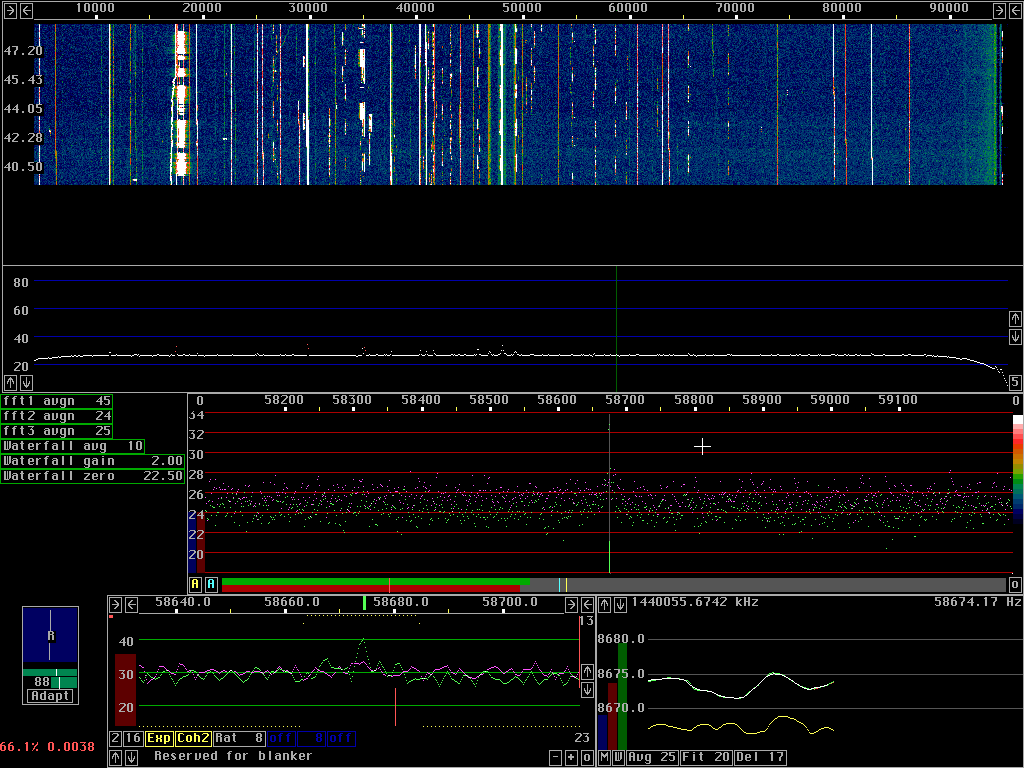|
The screen dump below shows 10 minutes of EME signals received
on Nov 11 2001 at 11.23 to 11.33 UTC.
With the settings used, all stations that reach red colour in the
waterfall graph can be copied, about 30 such stations can be seen.
The main filter in the baseband has a bandwidth of 20Hz. The bandwidth ratio between the main filter and the filter used to extract the carrier phase is 8 which means that the carrier is filtered out by use of a filter with 2.5Hz bandwidth. The bandwidth ratio is controlled by the white box "Rat" in the baseband graph. Both filters are implemented by back transforms of the fft's used to generate the baseband spectrum. For this reason fft3 has to have a large enough number of points to allow a filter of the desired bandwidth. At least 3 fft bins should be allowed for the narrow filter. Added summer 2010. Linrad-03.00 and later allow filtering in the time domain (FIR filters.) By selecting this option one can use just a single point for the narrow filter and use a smaller fft3 size with a somewhat smaller time delay from antenna to loudspeaker. The coherent mode control, the yellow box "Coh2" has four options: Off No coherent processing. Coh1 The output of the two filters go to the ear phones without further processing. Comparing the phase between the two channels is done by the human brain. This is a form of "binaural cw". Coh2 The phase that is extracted from the narrow filter is used to split the output of the wide filter into an I (in phase) and a Q (quadrature) signal. I and Q are routed to left and right ears respectively. If coherent CW is sucessful, the I signal should contain the desired signal with 3dB improved S/N while the Q signal should contain noise only. In fact S/N is improved by more than 3dB because only positive values of I are allowed to generate output while negative values that must be due to noise are rejected. Coh3 Differs from coh2 in that I is routed to both ears while Q is rejected. The selected station at about 144.059 is LZ2US. The frequency varies with time due to the combined unstability of our systems. The LO used to convert 144MHz to 10.7MHz is from an FT221, the accurate LO (with a DDS) can not yet be controlled from linrad. For the purpose of demonstrating coherent CW, the unstability is fine. The white curve shows that the frequency drifts by about 4 Hz in 10 seconds, but because of the AFC the frequency drift is smaller when the signal reaches the baseband. As can be seen from the nice sharp peak in the averaged baseband spectrum the phase of the signal is not destroyed by chirp, a problem that often is present on 144MHz. Coh2 mode is selected to investigate the sucess of the coherent processing. Practically nothing but noise can be heard in the Q channel so the procedure is successful despite the modest frequency stability. fft3 uses 30 bins to generate a bandwidth of 20Hz which means that one transform spans over 0.67 seconds. The spectrum is the average of 25 transforms which are 50% interleaved because of the sine squared filter in use. The baseband spectrum is thus the average over 8.4 seconds. The green rectangle above the carrier in the baseband graph is the frequency of maximum around which both baseband filters are centered. The AFC has compensated for most of the slow random FM modulation (frequency drift) and therefore the carrier is very sharp. When using a bandwidth ratio of only 8, the coherent CW is useful for direct ear reception but the signal threshold where carrier phase can be established is not good enough to allow coherent averaging. |
